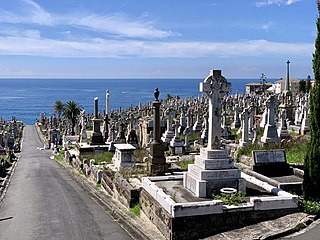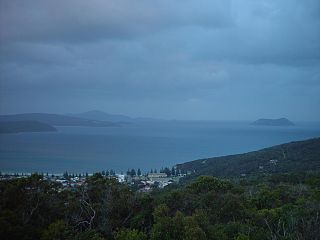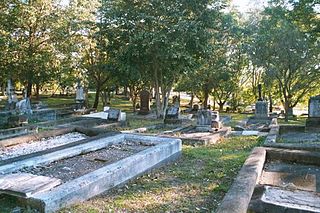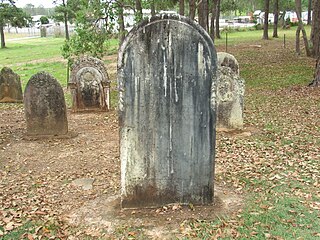
The Waverley Cemetery is a heritage-listed cemetery on top of the cliffs at Bronte in the eastern suburbs of Sydney, New South Wales, Australia. Opened in 1877 and built by R. Watkins and P. Beddie, the cemetery is noted for its largely intact Victorian and Edwardian monuments. It is regularly cited as being one of the most beautiful cemeteries in the world. The cemetery contains the graves of many significant Australians including the poet Henry Lawson. Also known as General Cemetery Waverley, it was added to the New South Wales State Heritage Register on 28 October 2016.

The Glasgow Necropolis is a Victorian cemetery in Glasgow, Scotland. It is on a low but very prominent hill to the east of Glasgow Cathedral. Fifty thousand individuals have been buried here. Typical for the period, only a small percentage are named on monuments and not every grave has a stone. Approximately 3,500 monuments exist here.

Arnos Vale Cemetery, in Arnos Vale, Bristol, England, was established in 1837. Its first burial was in 1839. The cemetery followed a joint-stock model, funded by shareholders. It was laid out as an Arcadian landscape with buildings by Charles Underwood. Most of its area is listed, Grade II*, on the Register of Historic Parks and Gardens of special historic interest in England.

Undercliffe Cemetery is located between Otley Road and Undercliffe Lane in the Bolton and Undercliffe ward, Bradford, West Yorkshire, England. The cemetery stands atop a hillside overlooking the city and contains some very impressive Victorian funerary monuments in a variety of styles. It is a notable example of a Victorian cemetery where a number of rich and prominent local residents have been buried, notably mill owners and former mayors. Undercliffe Cemetery is grade II* listed by English Heritage in their Register of Parks and Gardens of Special Historic Interest in England.

Toowong Cemetery is a heritage-listed cemetery on the corner of Frederick Street and Mt Coot-tha Road, Toowong, City of Brisbane, Queensland, Australia. It was established in 1866 and formally opened in 1875. It is Queensland's largest cemetery and is located on forty-four hectares of land at the corner of Frederick Street and Mount Coot-tha Road approximately four and a half kilometres west of Brisbane. It was previously known as Brisbane General Cemetery. It was added to the Queensland Heritage Register on 31 December 2002.

Fremantle Cemetery is a 46-hectare (110-acre) cemetery located in Palmyra, a suburb of Perth, Western Australia. Established in 1898, it is the location of over 40,000 burials and 60,000 cremations, including of several murderers and dozens of other notable Australians, and is the final resting place of AC/DC singer Bon Scott.

Mount Clarence is an inner suburb of Albany, Western Australia, between the Albany city centre and Middleton Beach. Its local government area is the City of Albany, and over three-quarters of its land area is either parkland or forest, including Albany's Heritage Park. Mount Clarence was gazetted as a suburb in 1979.

The West Terrace Cemetery, formerly Adelaide Public Cemetery is a cemetery in Adelaide, South Australia. It is the state's oldest cemetery, first appearing on Colonel William Light's 1837 plan of the Adelaide city centre, to the south-west of the city. The whole cemetery is state heritage-listed, including Smyth Chapel, and it is one of the oldest operating cemeteries in Australia.

The Gore Hill Memorial Cemetery is a heritage-listed cemetery located on the Pacific Highway in St Leonards, Sydney, Australia. It was established on 19 May 1868 by the New South Wales politician, William Tunks, and is one of the oldest and most significant remaining cemeteries in metropolitan Sydney. The first interment was in 1877, and until its closure for burials in 1974, 14,456 burials took place. Most burials took place between 1900 and 1930. It is also known as the Gore Hill Cemetery. The cemetery is situated on Crown land and is managed by a not for profit community organisation, Northern Cemeteries, through a Board of Trustees. It was added to the New South Wales State Heritage Register on 25 May 2001.

Nundah Cemetery is a heritage-listed cemetery at 88 Hedley Avenue, Nundah, City of Brisbane, Queensland, Australia. It was built from 1840s to 1963. It is also known as German Station Cemetery. It was added to the Queensland Heritage Register on 21 October 1992.

The English coastal city of Brighton and Hove, made up of the formerly separate Boroughs of Brighton and Hove in East Sussex, has a wide range of cemeteries throughout its urban area. Many were established in the mid-19th century, a time in which the Victorian "cult of death" encouraged extravagant, expensive memorials set in carefully cultivated landscapes which were even recommended as tourist attractions. Some of the largest, such as the Extra Mural Cemetery and the Brighton and Preston Cemetery, were set in particularly impressive natural landscapes. Brighton and Hove City Council, the local authority responsible for public services in the city, manages seven cemeteries, one of which also has the city's main crematorium. An eighth cemetery and a second crematorium are owned by a private company. Many cemeteries are full and no longer accept new burials. The council maintains administrative offices and a mortuary at the Woodvale Cemetery, and employs a coroner and support staff.

South Brisbane Cemetery, also known as Dutton Park Cemetery, is a heritage-listed cemetery at 21 Fairfield Road and Annerley Road, Dutton Park, City of Brisbane, Queensland, Australia, adjacent to the Brisbane River. It was built from 1870 to 1990s. It was added to the Queensland Heritage Register on 1 October 2003.

Gympie Cemetery is the cemetery for Gympie, Queensland, Australia. The cemetery is located on Corella Road and is managed by the Gympie Cemetery Trust.

Bolton Street Memorial Park, formerly known as Bolton Street Cemetery, is the oldest cemetery in Wellington, New Zealand. Dating back to 1840, many notable people are buried here. Situated in the suburb of Thorndon, the Wellington City Council's memorial trail number five covers the Bolton Street Memorial Park and visits notable graves, points of interest, lookouts and buildings.

Drayton and Toowoomba Cemetery is a heritage-listed cemetery at the corner of South Street and Anzac Avenue, Harristown, Queensland, Australia. It was surveyed in May 1850, and is one of the earliest surviving cemeteries in Queensland. The cemetery is large, containing over 45,000 burials. It has been run by the City of Toowoomba, and its successor the Toowoomba Regional Council, since 1974; previously it was run by government-appointed trustees. Many prominent people associated with the Darling Downs are buried in the cemetery, and all sections of the cemetery remain in use. Notable Toowoomba stonemasons R. C. Ziegler & Son, Henry Bailey, Walter Bruce, John H. Wagner and the Bruce Brothers are all associated with monuments within the cemetery.

Francis Lookout is a heritage-listed cemetery at 157 Dewar Terrace, Corinda, Brisbane, Queensland, Australia. It was built from 1863 to 1966. It is also known as Francis Outlook. It was added to the Queensland Heritage Register on 7 September 2004.

The North Brisbane Burial Ground was a former cemetery in the Town of Brisbane, Queensland, Australia. It was in the area now known as the suburbs of Milton and Paddington. It was also known as North Brisbane Cemetery, Paddington Cemetery and Milton Cemetery.

Cleveland Pioneer Cemetery is a heritage-listed cemetery at Lisa Street, Cleveland, City of Redland, Queensland, Australia. It is also known as Cleveland No.1 Cemetery. It was added to the Queensland Heritage Register on 18 September 2009.

Warwick General Cemetery is a heritage-listed cemetery at Wentworth Street, Warwick, Southern Downs Region, Queensland, Australia. It was designed by Dornbusch & Connolly and built from 1853 onwards by Phil Thornton. It was added to the Queensland Heritage Register on 27 April 2001.

South Rockhampton Cemetery is a heritage-listed cemetery at Upper Dawson Road, Allenstown, Rockhampton Region, Queensland, Australia. It was built from 1860 to 1970. It is also known as Dawson Road Cemetery and Rockhampton Cemetery. It was added to the Queensland Heritage Register on 15 February 1993.























